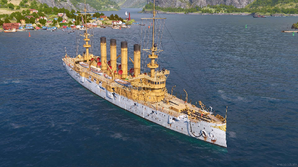St. Louis

| Hitpoints27 000 |
| Armor6 - 102 |
| Torpedo Damage Reduction0 % |
| 152mm Mk614x1 |
| Firing Range11.1 km |
| Reload Time8 s |
| 180 Turn Time22.5 s |
| HE Max Damage2100 |
| HE Fire Chance7 % |
| HE Penetration25 mm |
| AP Max Damage3000 |
| 76.2mm Mk418x1 |
| Firing Range2.5 km |
| Reload Time5 s |
| HE Max Damage1100 |
| HE Fire Chance4 % |
| HE Penetration13 mm |
| 7.6mm Hotchkiss Mk18x1 |
| DPS10 |
| Range1 km |
| Maximum Speed22 kn |
| Turning Circle Radius450 m |
| Rudder Shift Time6.4 s |
| Detectability by Sea9.1 km |
| Detectability by Air5.4 km |
| Detectability firing in smoke4 km |
Modules
 |
Hit Points | Min Armor (mm) | Max Armor (mm) | Torpedo Damage Reduction (%) | Main Battery Turrets | Rudder Shift (s) | Purchase Price |
|---|---|---|---|---|---|---|---|
| Stock | 25 000 | 6 | 102 | 0 | 10x1 | 8.4 | 0 |
| Hull B | 27 000 | 6 | 102 | 0 | 14x1 | 6.4 | 2600 |
 |
Turret Arrangement | Reload Time (s) | 180° Turn Time (s) | Max HE Damage | HE Fire Chance (%) | Max AP Damage | Purchase Price |
|---|---|---|---|---|---|---|---|
| 152mm Mk6 | 10x1 | 10 | 30 | 2100 | 7 | 3000 | 0 |
| 152mm Mk6 | 14x1 | 8 | 22.5 | 2100 | 7 | 3000 | 320 |
 |
Firing Range Increase (%) | Main Battery Firing Range | Purchase Price |
|---|---|---|---|
| Stock | 0 % | 10.1 km | 0 |
| Targeting System Mk2 mod. 2 | 10 % | 11.1 km | 320 |
 |
Maximum Speed |
|---|---|
| Stock | 22 kn |
Modifications
Consumables

| Accelerates repairs to damage modules, firefighting efforts and recovery from flooding. |
|
Player Opinion
Performance
History
USS St. Louis (C-20, later reclassified as CA-18) was a protected cruiser and the lead ship of her class, laid down for the US Navy in 1902. Originally designed as an improvement over the USS Olympia, she was heavily reworked, ending as a large protected cruiser having a similar displacement to contemporary armoured cruiser but with less protections : some authors considered them as “semi-armoured cruisers”.
Commissioned in 1906, USS St. Louis was assigned to the Pacific Fleet in 1907 following her trials. In 1909, she was put into reserve and decommissioned the next year to be recommissioned, still in reserve, in 1911. In 1912, St. Louis returned to reserve in the Pacific Reserve fleet, where she stayed until 1914, when she became a receiving ship at San Francisco. She returned again to reserve in 1916. The same year, she was assigned as a submarine tender for the Submarine Division Three of the Pacific fleet. In 1917, her crew boarded the German sloop Geier to avoid her scuttling at Pearl Harbour. When the United States entered the world war, she was assigned to escort duty in the Atlantic while still in half-commission. The same year, she was accepted in full commission and spent the majority of the conflict escorting convoys. After the Armistice, St. Louis contributed to bring back home the US Troops deployed in Europe between 1918 and 1919. Redesignated as CA-18, St. Louis was assigned to the European Squadron and fulfilled humanitarian duties in the context of the Russian Civil War and the Turkish Revolution. She returned home in 1921 to start pre-inactivation work, and she was fully decommissioned in 1922. Kept into reserve until 1930, when St. Louis was sold for scrap to respect the tonnage limitations of the London naval treaty, alongside her sister ships.
Sources :
- Friedman, Norman, U.S. Cruisers: An Illustrated Design History, Annapolis, Naval Institute Press, 1984
Gallery



